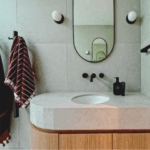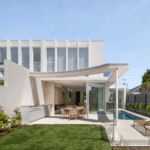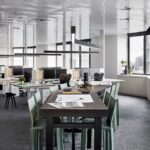Wellness Interior for South Korean Cafe
FROM THE ARCHITECTS Just like us, plants grow and buildings age.

GALLERY
The process of decay in this particular case was natural. Concrete roof tiles fell into the building as purlins eroded and timber frames rotted away. Due to these structural damages, the roof opened up to the sky, and the floor reverted to earth. These three buildings, once used as a dormitory for factory workers, were abandoned as nearby factories closed. In a shrinking town, on a distressed building, wild plants gradually replaced humans. This decay gradually transformed the site into an interior garden, providing a sanctuary for plants.
The three rectangular-shaped buildings stood parallel to one another. The thickest building on the northern side served as the home for the family who managed the dorm, while the other two slender buildings, one with three units in the middle and the other with four units on the southern end, housed factory workers and their families. The small unit sizes (12 sqm) and the proximity of the buildings (1.2m) made it impractical to fully maintain the existing structure for modern-day use.
In our effort to breathe new life into this site, we systematically demolished sections of the walls and roof to allow for better air circulation, sunlight penetration, opportunities for plant growth, and spaces for people to roam. Furthermore, it liberates the existing building from its structural, MEP, and HVAC burdens.
After partially deconstructing the buildings, new columns, and roof structures were installed. The northern building, now a café, is the only fully interiorized, insulated, climate-controlled space. All walls were removed except for the two exterior sides in the middle building. We excavated the ground further to create a sunken garden, providing an open-air space for trees and grass to thrive. The southern building had its interior walls preserved, but the ones facing the middle building and the vacant lot were demolished. Those units were then transformed into raised floor seating. To connect the existing buildings, we constructed an elongated pathway on the site’s eastern end.
From their gradual decay in the face of nature’s forces to our deliberate efforts to breathe new life into this site, Dabang offers a sanctuary that integrates plants, humans, and the built environment.
Architects one-aftr
Photographs Jang Mi
Contractors Full Raum Design
Project Managers Joon Ma, Ryu Ahn
Team Members Yoonha Lee, Bomi Son
Building a new home presents a blank canvas, allowing you to create bespoke spaces for comfortable day-to-day living ...
This light-filled, custom-built Bayside residence by Dash Construct, is enhanced by light and architectural design that defines modern ...
Studio Tate has completed a lavish redesign of the 17th floor of a distinctive hexagonal building in Melbourne, ...










